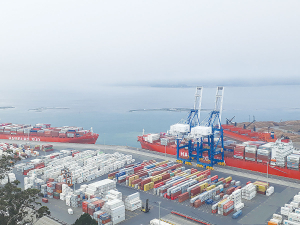M.I.A.
OPINION: The previous government spent too much during the Covid-19 pandemic, despite warnings from officials, according to a briefing released by the Treasury.
 The current disruption in the Red Sea has impacted shipping capacity, particularly for vessels that service European and Asian routes.
The current disruption in the Red Sea has impacted shipping capacity, particularly for vessels that service European and Asian routes.
Covid-19 took global shipping rates to mind boggling highs, but over the subsequent 12-15 months they returned to more sustainable levels. Fast forward to July 2024 and rates have nearly doubled over three months.
The main reason is the current disruption in the Red Sea, where Houthi rebels are targeting ships linked to Israel, the US or Britain, as part of their support for the militant group Hamas in its war against Israel.
This has impacted global shipping capacity, particularly for vessels that service European and Asian routes. Since December 2003, authorities report a near 50% fall in ships traversing the Suez Canal, with a reduction of around 40 vessels per day.
In contrast, this reduction is offset by a 70% increase in vessels navigating the less direct Cape of Good Hope, which increases the distance travelled by 40% and adds delays of two to five weeks.
Compounding the issue are a global shortage of shipping containers and congrestion at some Asian ports. At the same time, global export demand is recovering following the post-Covid lull of 2023, with the World Trade Organisation predicting a 2.6% increase in exports for 2024.
The rising cost of doing trade, particularly if the problem deepens, poses a risk to the New Zealand economy, already facing high interest rates, margin pressure, wage rises and climbing unemployment. Any sustained rise in shipping costs is likely to complicate the Reserve Bank's task of getting inflation back to its 1-3% target band.
Fortunately, the current rise in shipping costs is expected to be less inflationary than the surge experienced during Covid-19. Container production, largely driven by demand to move exports from China to the West, has increased substantially over the last few months, while the disruptions experienced in the Panama Canal appear to be easing. Although a much smaller chokepoint than the Suez Canal, it still accounts for around 7% of global seaborne trade. The 'Panama Problem' was caused by an extended drought in 2023 that reduced the number of vessels able to use the canal and led to draught limits that reduced operating weights.
Currently, water levels in Lake Gatun, the main body of water that feeds the system, have been rising steadily since April, meaning that by early August, up to 34 ships per day will be able to use the canal. This is a major increase on the 24 vessels per day that had access at the start of the year and not far behind the more typical 36-28 vessels that use the canal in normal times.
Further complications to global shipping include an increase in off-schedule arrivals, which are deeply impacting logistics managemnt and increasing congestion at some Asian ports. Key locations such as Singapore and Shanghai are experiencing extended delays in entering the ports and increased unloading and loading times. In some cases, they are unable to load enough empty containers, with captains choosing to leave ports partially loaded to try and regain schedules, with a resultant shortage of empty containers in Oceania.
Industry sources suggest that the true effect of the increased costs might take a little while to show up accurately, with data collection typically three to six months in arrears.
Legal controls on the movement of fruits and vegetables are now in place in Auckland’s Mt Roskill suburb, says Biosecurity New Zealand Commissioner North Mike Inglis.
Arable growers worried that some weeds in their crops may have developed herbicide resistance can now get the suspected plants tested for free.
Fruit growers and exporters are worried following the discovery of a male Queensland fruit fly in Auckland this week.
Dairy prices have jumped in the overnight Global Dairy Trade (GDT) auction, breaking a five-month negative streak.
Alliance Group chief executive Willie Wiese is leaving the company after three years in the role.
A booklet produced in 2025 by the Rotoiti 15 trust, Department of Conservation and Scion – now part of the Bioeconomy Science Institute – aims to help people identify insect pests and diseases.

OPINION: The release of the Natural Environment Bill and Planning Bill to replace the Resource Management Act is a red-letter day…
OPINION: Federated Farmers has launched a new campaign, swapping ‘The Twelve Days of Christmas’ for ‘The Twelve Pests of Christmas’ to…